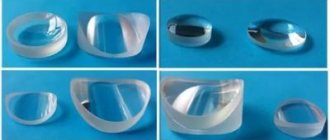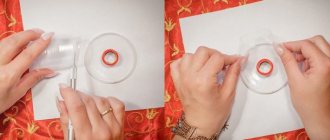The first association that arises when you mention Euro-windows is single-chamber or double-chamber PVC structures in white. These are the windows that are installed in most apartments and private houses, replacing outdated frame structures. An alternative to plastic windows, which are inferior to wooden ones in terms of environmental friendliness, but superior in terms of performance characteristics, is Euro-windows made of wood. Their parameters are impressive, their appearance is up to par, and they are environmentally friendly. Unlike a plastic one, a wooden window frame with a proud “euro” prefix can be made independently. Making wooden windows with your own hands is a common thing for many FORUMHOUSE users.
DIY Eurowindow
Eurowindow - what is it and how is it done?
Eurowindow is a structure consisting of a frame, double-glazed windows and perimeter fittings controlled by a handle.
Perimeter fittings are a prefabricated harness made up of several parts mounted along the entire perimeter of the profile. It provides locking of the sash at several points, using one handle, which allows you to achieve the tightest possible fit and eliminates blowing. Thanks to this fittings, a window with an opening sash can operate in two modes – tilt and turn. In the rotary mode, the window opens only by turning; in the combined mode, the window sash opens and tilts.
The fundamental design difference between Euro windows and conventional windows is one frame, which can accommodate several double-glazed windows. The main technical characteristic of the “euro” is complete tightness, achieved through various seals. Thermal conductivity will depend on the number of air chambers, and on the type of glass in the double-glazed window, and on the correct installation of the window. Therefore, the material from which the profile is made does not play a significant role; the functionality of the structure and its characteristics are important.
Box
Pine is the most popular material for making boxes among middle-class consumers. It is affordable and practical to use.
An oak window will be of better quality. But this material is quite expensive, so experts do not recommend making a window structure from it for the first time. Also, do not use soft wood.
The pine boards that will be used for the box must be properly dried.
If you have chosen laminated veneer lumber, then, subject to high-quality installation, you are guaranteed to receive a window of high strength; it will not change its parameters during operation.
To avoid subsequent deformation, the window block should be a couple of centimeters smaller than the opening.
Depending on the thickness of the window, a timber of a certain size is selected. The minimum value is 6*4 cm.
Grooves in the timber can be made using a router or electric planer. Before carrying out this stage of work, it is best to practice on a separate piece of the board.
First you need to take measurements, according to which the box can be made. In the blanks for it, grooves in the shape of the letter G should be made to a depth of 1.5 cm. The ends of the bars are sawed off at an angle of 45˚. After this, all the elements of the window frame must be connected with wood glue, holes must be made in them, through which wooden rods 3 cm long must be inserted.
Thus, the resulting structure will become motionless and rigidly fixed at a right angle.
The opening into which the box will be installed must first be prepared: cleaned of debris and dirt, leveled. Holes should be drilled in the walls (in increments of no more than 80 cm) into which dowels should be driven. The box is secured with self-tapping screws.
After this, using polyurethane foam, you need to seal all the gaps between the walls and the box. The advantage of this fixation is the following: the design does not depend on temperature changes.
It must be remembered that the geometry of the window must be strictly observed: angles - 90˚, difference in diagonals - no more than 10 mm, deviations in evenness - no more than 1 mm per 1 m of window block length.
DIY wooden windows
The process of manufacturing a wooden euro-window will require certain financial investments - the cost of wood, components, equipment. It is also easier to order double-glazed windows from professionals, although some craftsmen manage to assemble this unit themselves. But even taking into account the impressive cost of the finished product, which is an elite and therefore quite expensive product, the savings will be significant. If we are talking about building a new house or completely glazing an old one, the difference can be tens of thousands.
Double-glazed window
If you need a double-glazed window, there must be two frames. They are made in the same way. After both halves are ready, the glass is laid on the table, the film is removed from the end of the profile, if butyl tape has already been glued there.
The following is the order:
- Remove the film from the top surface of the frame.
- Place the second glass on the frame - check that it is flush with the first.
- Do the same with the second frame.
- Crimp the glass unit - the butyl should adhere tightly to the glass.
- Fill the outer end of the glass unit with polyurethane-polysulfide sealant - this is done with a special spatula.
- Wait approximately 12 hours (or whatever is written on the sealant package).
- Remove any remaining sealant and sand.
Materials, tools, drawings, connection of elements
Windows are constantly exposed to external influences and temperature differences between indoors and outdoors, which inevitably leads to changes in the geometry of the structure when it comes to wood. To minimize possible warping, frames and sashes are made not from solid timber, but from laminated veneer lumber. You can purchase a ready-made one if there are reliable suppliers, or you can glue it yourself. In the second case, a workpiece of at least three lamellas is assembled, so that the fibers are directed in opposite directions. If possible, choose radial sawn wood; tangential sawn wood “leads” more. For gluing, special, moisture-resistant compounds should be used.
The section of the beam is chosen based on the number of double-glazed windows - for a window with one chamber, a 6x4 cm beam is usually used. In production conditions, grooves are selected in the frame not only for the double-glazed window and external seals, but also for internal ones. One of the former manufacturers of wooden European windows shared his drawings, by simplifying which you can get high-quality structures that are almost as good as ready-made ones. In order to make a window with your own hands, the drawings are quite suitable.
Considering that not everyone has professional equipment, and its purchase will negate all savings and is justified only for the purpose of manufacturing windows for sale, home craftsmen choose grooves for double-glazed windows, external sealing and fittings.
For these purposes, a milling cutter, a circular saw, and a hand tool for finishing are used. The participants of our portal are equipped with all the necessary equipment and Ravildon decided to make a window together with his brother (nickname Halvasenshiy) for his house.
RavildonForumHouse Member
We had hand tools, machines and other equipment. We welded a table, attached a hand router to it, bought a microtenon cutter and a movable carriage, and decided to dial the profile in length and thickness. A purchased profile costs from 1,600 rubles for six meters, so we will trim the finished beam, glue it, and then increase its thickness.
HalvaseniorForumHouse Member
They made this kind of pepelats: I had guides with carriages lying around, welded the frame, attached a manual circular saw to the movable table, and the result was a simple impostnik. The grooves are rectangular, so you can do without shaped cutters. The cutting depth is adjusted by a movable stop, the height by a set of plates and rectangular pipes. I cut the groove in five passes, changing the linings, and finished it with a file.
The brothers trained on waste, and the results were recorded in a journal so that in the future they could choose the most successful option. Once we got the hang of it, we started making the frames themselves.
Another of our forum members used ready-made laminated veneer lumber. The photos show this whole big process in detail.
cyan__FORUMHOUSE Member
The purchased timber was passed through a surface planer and a trimmer, on a circular saw with a homemade device (a high parallel stop with guides and 0.5 mm rulers) I made tenons and a profile, glued it together, selected the fitting grooves with a milling cutter, hung the fittings - checked how it worked, removed it, sanded it for painting. There are no special tricks, but you either need to have experience in carpentry, or first make several throwaway frames - practice.
Since the double-glazed window is planned to be double-chamber, the total cross-section of the timber turned out to be 80×78 mm.
If equipment and experience allow, the frame elements are cut obliquely, at an angle of 45⁰; they can be joined without a bevel, which, although less decorative, is technically easier. The parts are assembled using a tongue-and-groove joint, with the vertical parts being lugs and the horizontal parts being tenons. It is easier to make a single joint, but a double joint is stronger and more durable, since the gluing area increases; a triple tenon is even stronger. When there is only one tenon, it is worth additionally strengthening the frame with a corner, since the double-glazed window significantly makes the structure heavier.
Our portal member cyan__ tells how to make a wooden window using a three-tenon joint.
cyan__
I made three tenons for myself and put them on PU D4 glue, on another glue and one tenon under the double-glazed window, I would probably put a corner. As a test, you can glue one corner and test it for strength and deformation, loading it along the hypotenuse with a mass of one and a half glass units. Then it will become clear whether additional reinforcement is needed.
Features and subtleties of self-made frame
Work begins with careful measurement of window openings. If you plan to make several frames, you need to take measurements for each opening separately, since the parameters of even two adjacent openings may differ by 1-1.5 cm. And measurements of the width and height of the opening should be taken in several places.
Having received all the dimensions, we begin designing. There are three main types of double-glazed windows:
- Blind window. In this case, the entire surface of the opening is covered with one double-glazed window.
- Double-leaf window. In this case, the opening is divided into two approximately equal halves, which open in the form of two doors to the sides.
- A single-leaf design, as a rule, has one large-area leaf that opens to the side or folds down like a transom. The second door is closed tightly.
In addition, the drawing may include windows, transoms and other additional elements. Wood allows you to realize the most unusual window shapes. The imagination of designers extends from classic rectangular windows to round, triangular and openwork stained glass designs.
The choice of material is the next important task that must be solved at the design stage. As a rule, beginning craftsmen choose pine. Its wood is well processed, relatively light and does not require too much expense. Other types of wood are also suitable. The only exception for beginners is oak. It is difficult to work with due to its hard wood, so it is not suitable for beginners.
Experts recommend that beginning craftsmen purchase boards made from well-dried wood. Self-drying is a labor-intensive and responsible process, and if you make a mistake, it is easy to ruin the board until it is completely unsuitable for further use. In addition, a novice carpenter is advised to carefully check the lumber and reject all samples that have knots.
Blanks are cut from the prepared timber or boards, strictly observing the dimensions indicated on the drawings. The more carefully all proportions of parts are observed, the fewer problems will arise during assembly. Having prepared the blanks, they are folded in the order in which the assembly will take place.
Templates from the corner
Halva Sr. assembled a box of two lamellas to make it easier to select quarters and grooves for seals with a circular saw. There was no dried timber of the required thickness, either solid or glued, on sale at that time; we had to make do with material with a smaller cross-section. But the timber we found was dry, already jointed on all sides. The frames were glued onto a smooth fugue due to the lack of a comb of suitable width. To be on the safe side, the structure was reinforced with self-tapping screws - diagonally, from the edge to the center (the fastener heads will later be hidden by a quarter). After the final blowing with pneumatics, the finished frames were given to the eldest son for finishing - for putty
Windows made industrially are no better than so-called do-it-yourself windows - the photo confirms this.
The grooves for fittings in the sashes are selected based on its type and dimensions. To simplify his work, Halva the Elder made metal templates, according to which he selected all the necessary grooves.
Halva senior
Before cutting the tenon and groove, I prepared the grooves for the locks - I made a template from a bent steel angle. The holes are 8 mm in diameter, the screw hole is 10 mm in diameter. First, mark the centers, then drill 8 holes - depth 26 mm. I set the stop and used a hand router to combine the holes into a groove, dimensions: depth 28 mm, width 8 mm. I did without length limiters - the boundaries of the groove can be felt to the touch.
Correct measurements
To make a regular double-glazed window, you will need the height and width of the window.
Before you start making a double-glazed window at home, you need to correctly determine all the parameters. They are removed from the inside and outside. It is important that the depth of the opening is correctly determined. It is especially important to take measurements accurately in a panel house. Cases often arise when the opening is significantly skewed. This is due to the fact that the slabs and blocks are already used in cast form.
Most windows have ledges. In construction they are called quarters. According to standards, their length is 6.5 cm, 1/4 brick. A correctly measured window structure should stand 1.5 cm higher than the lower edge of the quarter so that a drainage system can be installed under the frame. The window extends beyond the upper quarters by no more than 1.5 cm, and beyond the side quarters by 4 cm.
The frame should not touch the opening itself. A gap of at least 4 cm is left between them for pouring polyurethane foam.
When taking measurements, it is necessary to take into account the place for pouring polyurethane foam.
You need to start measuring from the outside. Three centimeters are added to the width of the slope. The width of the PVC profile structure should be greater than the opening and a quarter. When installed, the window itself rests on the slopes.
To determine the height of the product, you need to measure the distance from the edge of the top quarter to the base. You must subtract two centimeters from the resulting size. The result will be a place for the assembly seam.
If the window will be installed with low tide, the vertical measurement must be removed by another 4 to 6 centimeters. This distance will go to the stand profile.
Chamfering, assembly, finishing
All instructions recommend chamfering the joints; this improves the appearance of the frames, since minimal mismatches in the mating elements are hidden.
A cut or rounded corner is covered with a thicker layer of paint and varnish than a sharp one, therefore, it is more resistant to all external influences. Forum member Sukhov76, who made wooden windows for himself, advises his own method.
Sukhov76FORUMHOUSE Member
Instead of chamfering at 45⁰, it is better to round the corner by a radius of 3 mm - it looks more aesthetically pleasing and lies well under paint. Paints and varnishes are “afraid” of sharp edges, according to the law of surface tension, on sharp surfaces the paint layer is thinner, and according to the law of meanness, it is the edges that are the most vulnerable in operation, and the coating wears off faster, but on a radius the layer is even and is more difficult to damage.
The assembled window frames and sashes are sanded and treated with special impregnations, and then varnished or painted. In order for each subsequent layer to apply well and last a long time, all compositions used must be on the same base, water, etc. The glass in the frame is secured with glazing beads.
It’s not enough to make a window with your own hands - the video on our portal will teach you how to paint it correctly to protect the surface for many years!
For the second floor of his house, cyan__ also made wooden windows himself, using the technology already given. After the blanks were cut, grooves and tenon joints were selected, holes for fittings and frames were assembled, the final part remained - finishing and installing glass.
cyan__
Primed and painted the outer white side. Then, by sanding, I removed paint drips on the masking tape in a couple of places - the inner, translucent one. The stain is not paint; on the white side, if anything happens, it can be easily wiped off with a wet rag. I installed the glass on spacers and nailed the glazing beads - a copper nail every ten centimeters looks good. I sealed it with neutral (this is important) silicone; acidic silicone can destroy the sealant of the bag. I turned it over onto a sheet of foam rubber and sealed the reverse side, mounted the fittings, mounting plates and inserted it into the opening. The final step was to adjust the sash and insert seals into the grooves.
Types of faults
Over time, the sash begins to work intermittently or sag. There is a skew of the transom under the weight of the glass unit.
Other damage may occur:
- the handle is difficult to turn;
- the transom is not fixed in the folded or closed position;
- it blows from under the glazing bead;
- glass fogs up inside and outside;
- Mold appears on the window slope and frame, and water streaks are visible.
There are instructions for repairing mechanisms; the fittings contain adjusting screws and parts for coordinating the work.
Conclusion
Making a wooden window with your own hands is an opportunity not so much to save money as to express yourself. For many years, a beautiful, environmentally friendly design will remind you not of the money spent, but of your own skill.
Everything related to the technical parameters and features of Euro-windows, as well as step-by-step instructions, diagrams, installation details and characteristics of products from different manufacturers are discussed in the “Windows, profiles, glazing” section. Details of the manufacture of the wooden windows mentioned in the article are laid out step by step in the topic “Report on the creation of wooden windows”. After studying the article about the technology of gluing boards, you will learn how to obtain high-quality and durable timber for future frames. How to replace wooden windows with your own hands without dismantling the old frame - a video about new technology answers this question.
Subscribe to our Telegram channelExclusive posts every week
Advice from professionals
Each case has its own nuances, which become obvious only after gaining significant practical experience. We recommend that you watch several helpful videos that will help you get acquainted with the experience of professional window manufacturers. We hope that these tips will be useful in your work:
It is quite possible to make a window with full double-glazed windows from wood at home. Carefully study the technology before starting work, carefully prepare drawings and carry out all operations without haste. And then the finished window will serve you for many years.
Consequences of glass replacement
Replacing only broken glass at home with your own hands can lead to the window starting to fog up inside the repaired double-glazed window. Even provided that its sealing is done efficiently. Repairs are usually carried out in the summer or during the cold season in a heated room.
In winter, in cold weather, on the surface of the inner glass of a single-chamber package or on the middle glass of a two-chamber package, conditions arise for the appearance of condensation of water vapor, which will certainly be in the air inside the chamber. And the moisture absorption capabilities that were inherent in the molecular sieve spacer during factory installation will already be exhausted. This is why it is recommended to replace the entire cracked glass unit.
If energy-saving i-glass breaks, then when replacing it with regular glass, the window will completely lose its energy-saving properties, and condensation will definitely appear - the spacer of such a window does not have perforations. And inside the frame is silica gel (molecular sieve), since instead of air at the factory, inert gas is pumped into the chamber. And quite often such windows have a single glazed unit. Therefore, when replacing cracked glass at home, you get a “cold” window.











